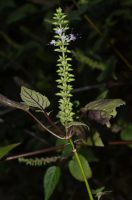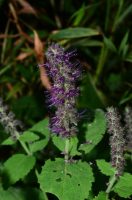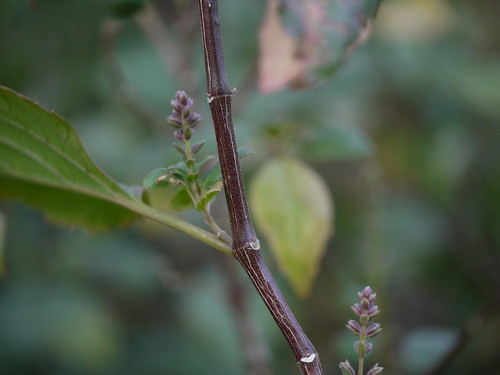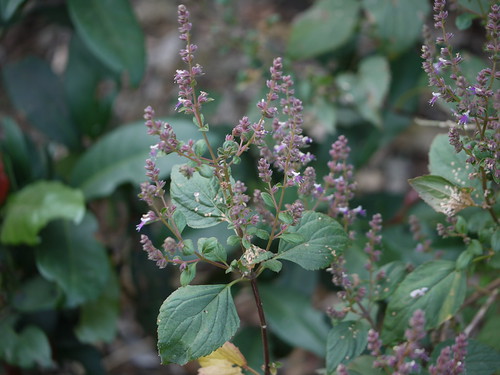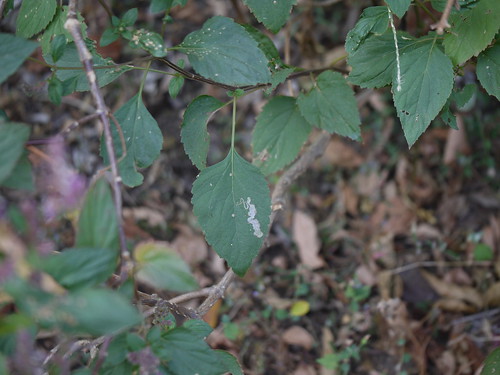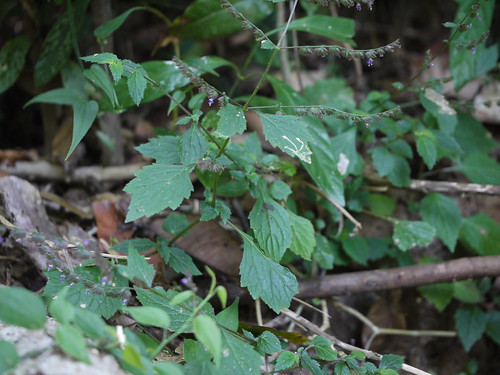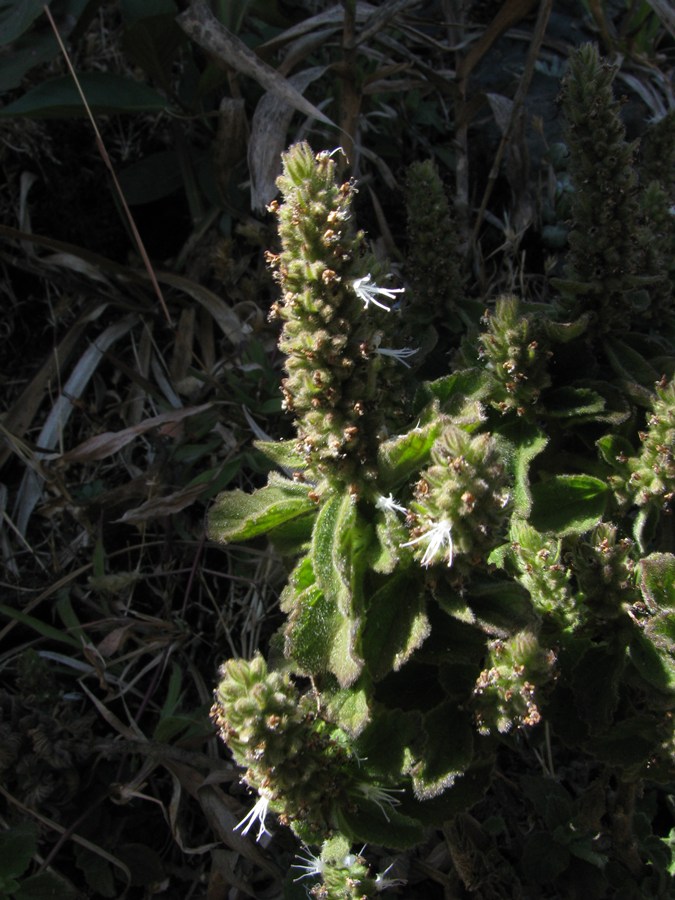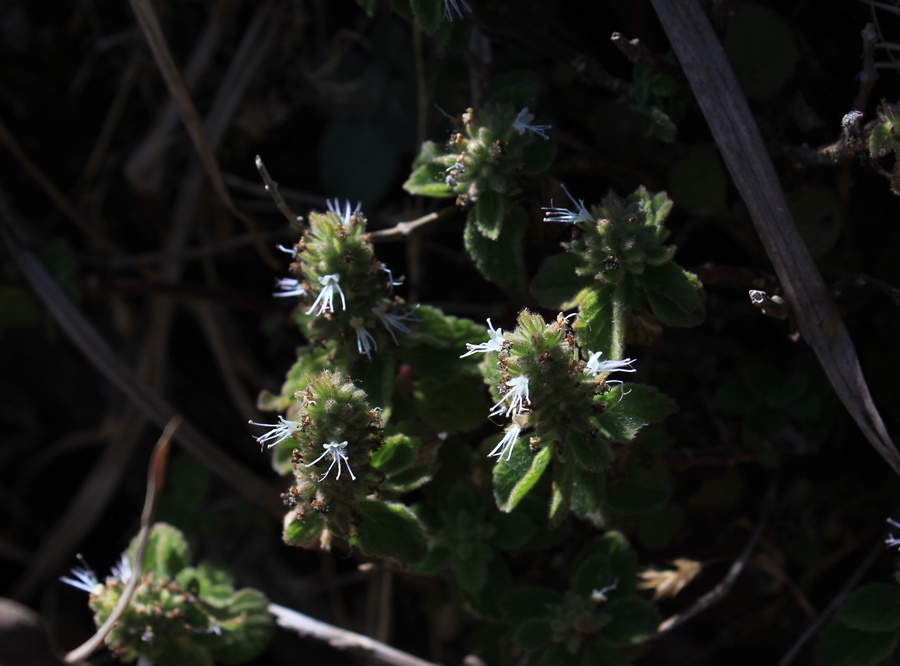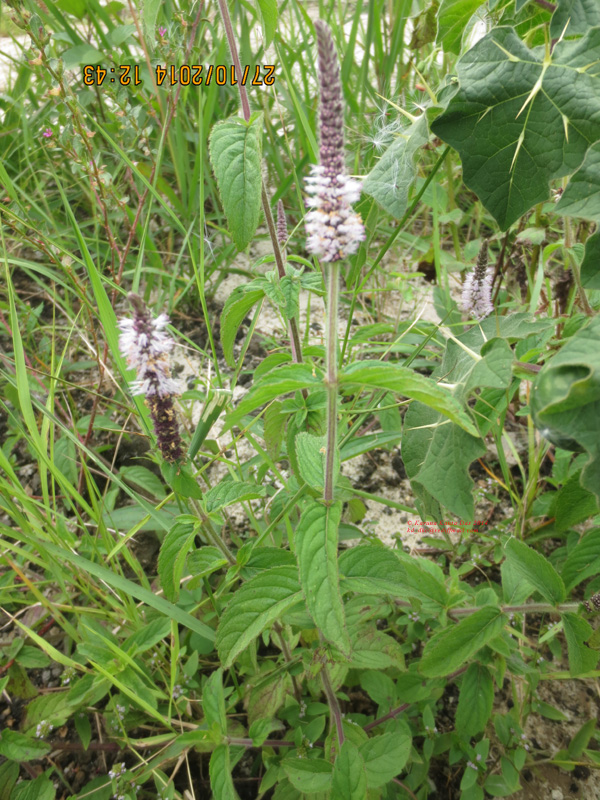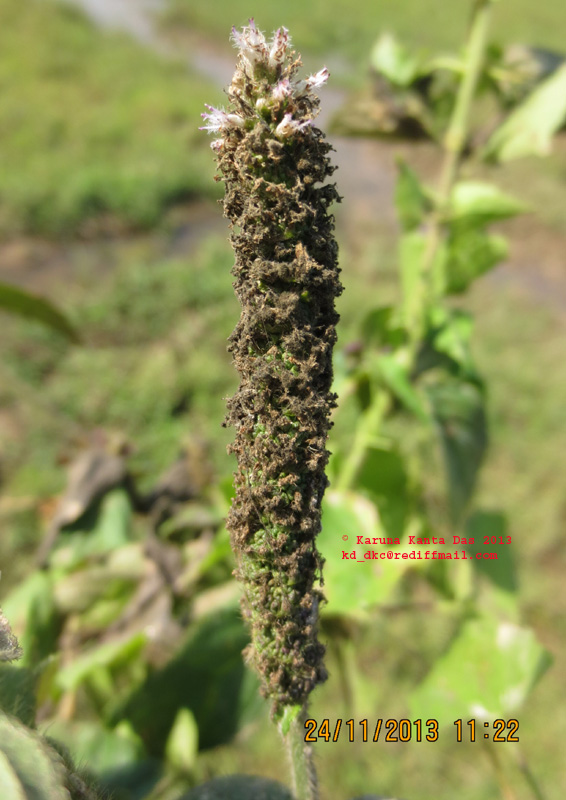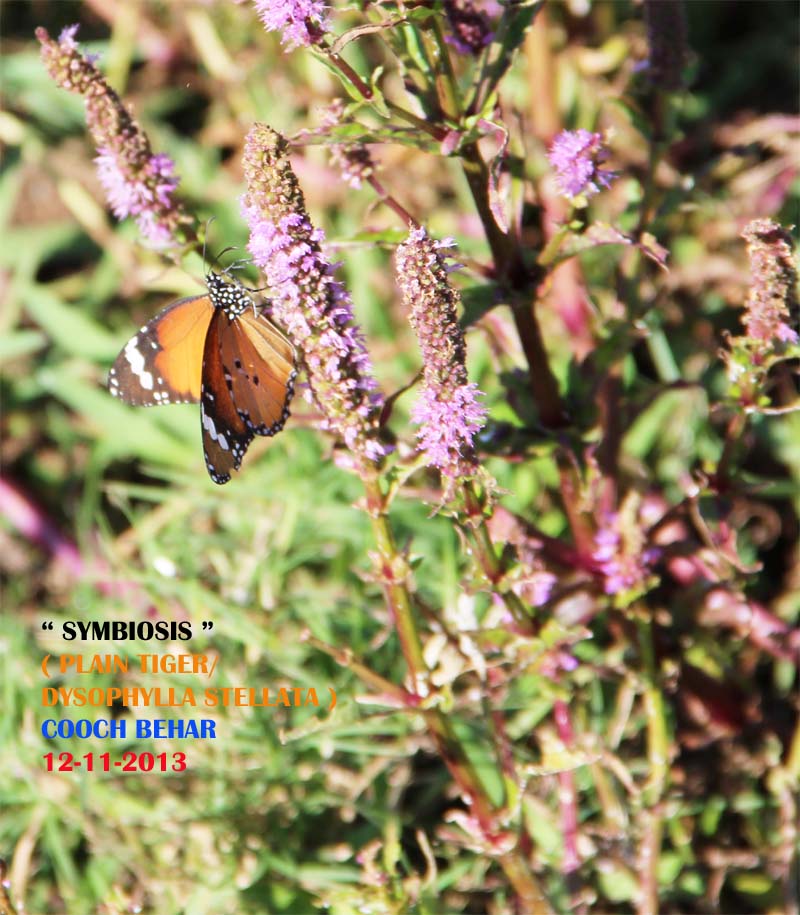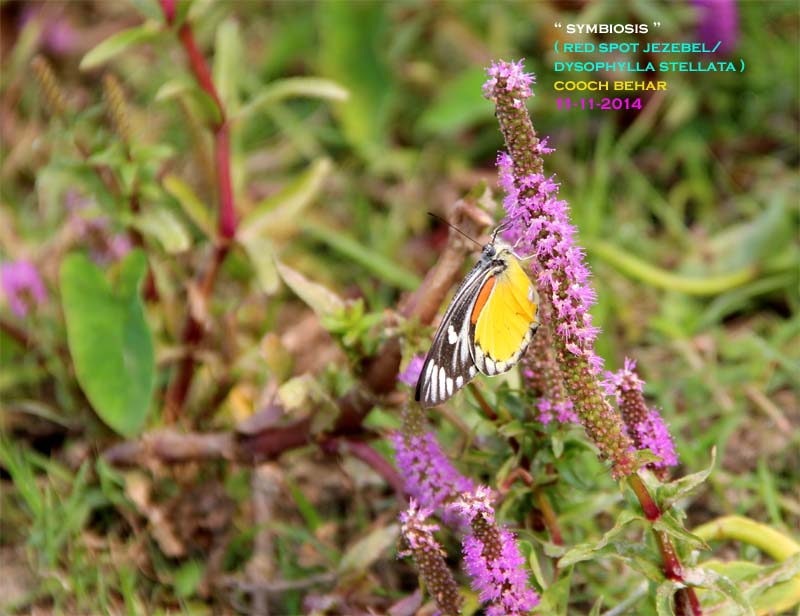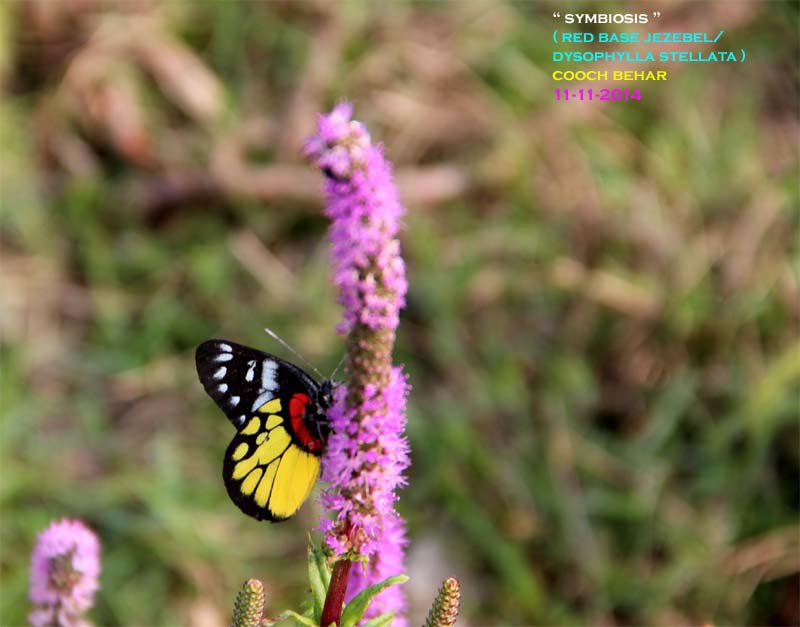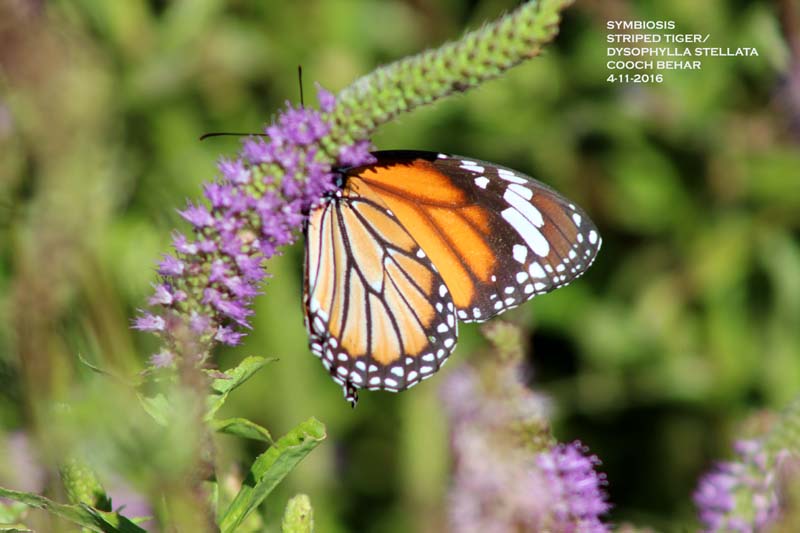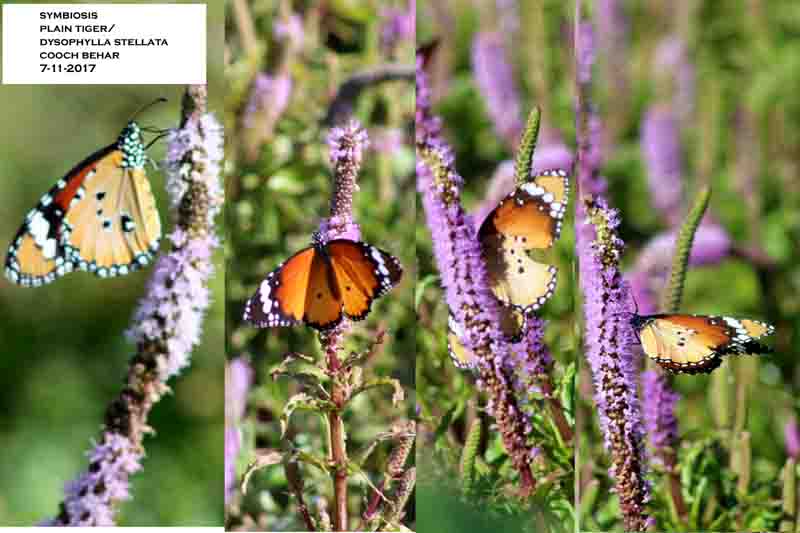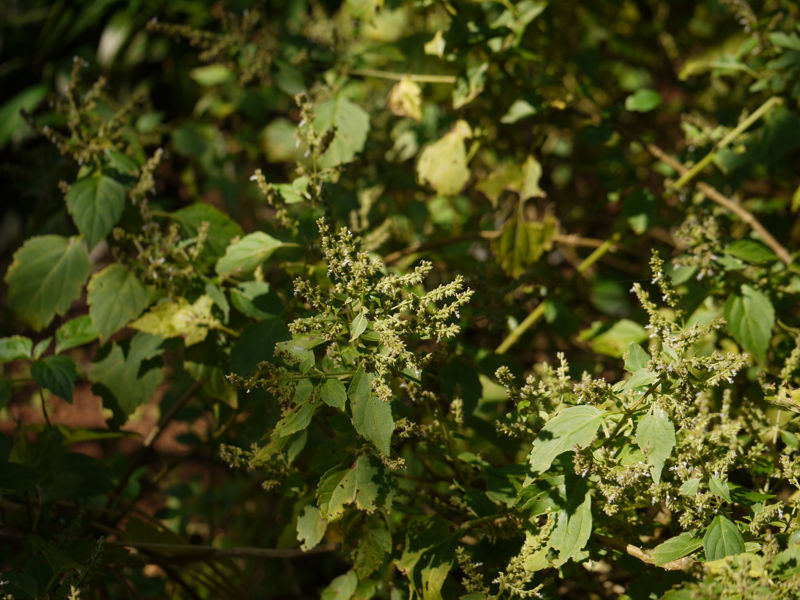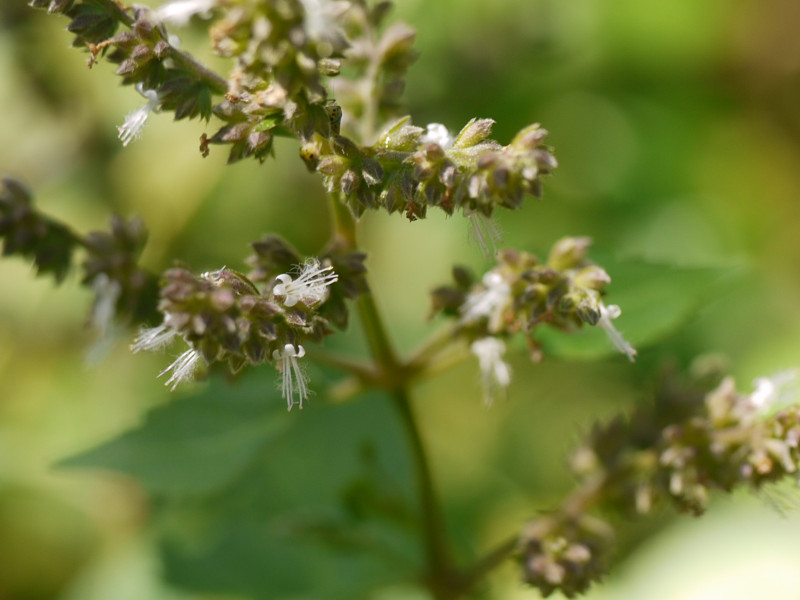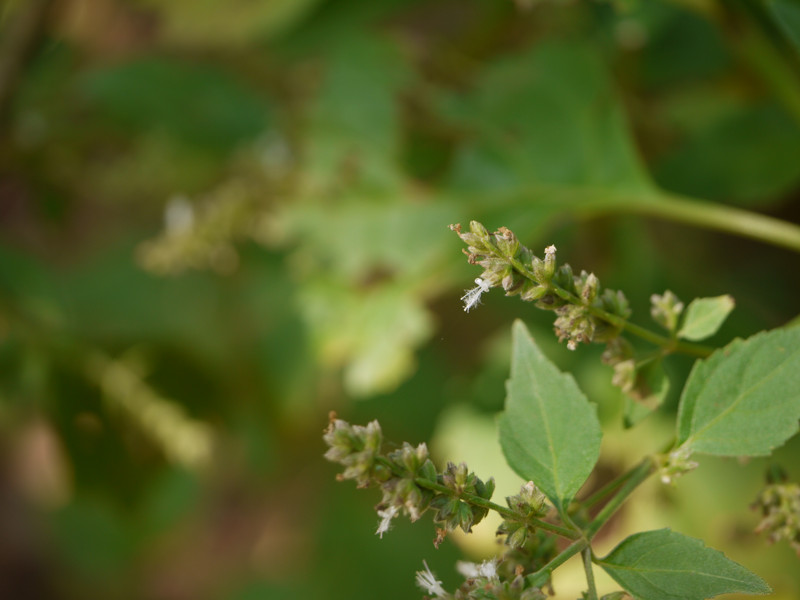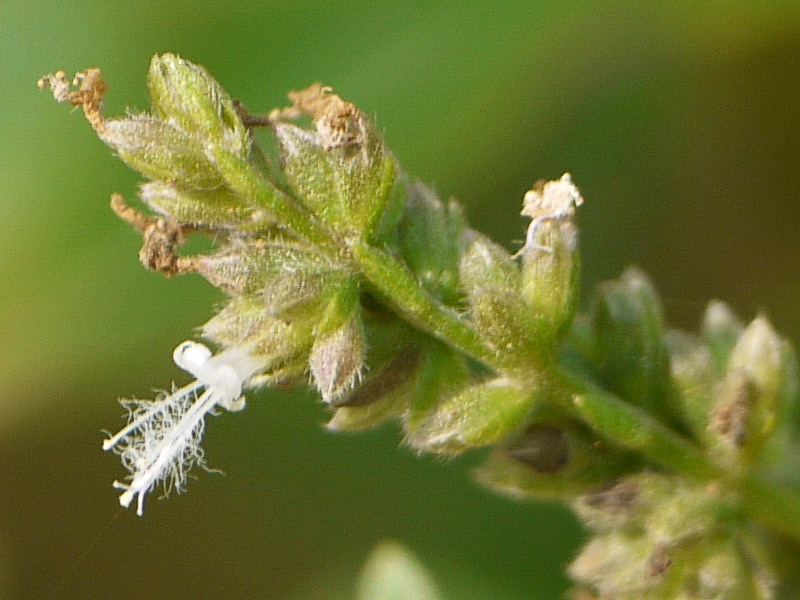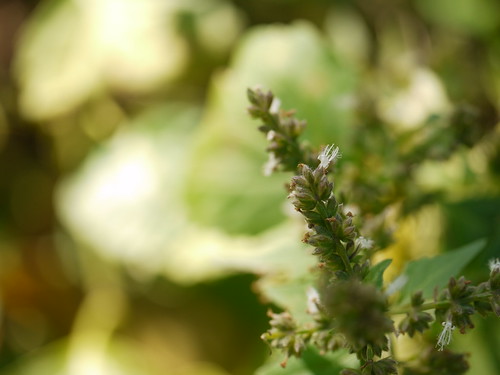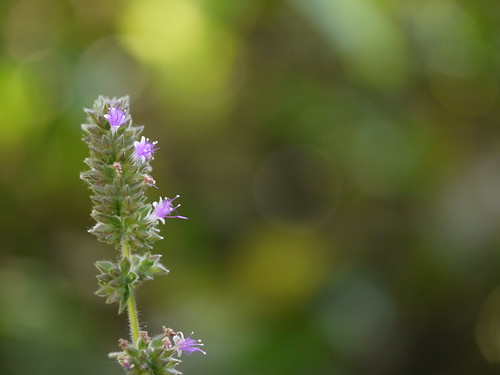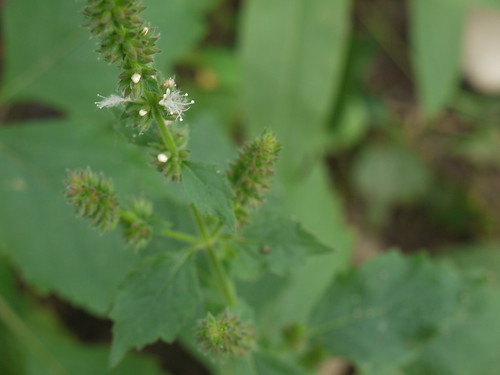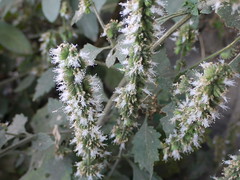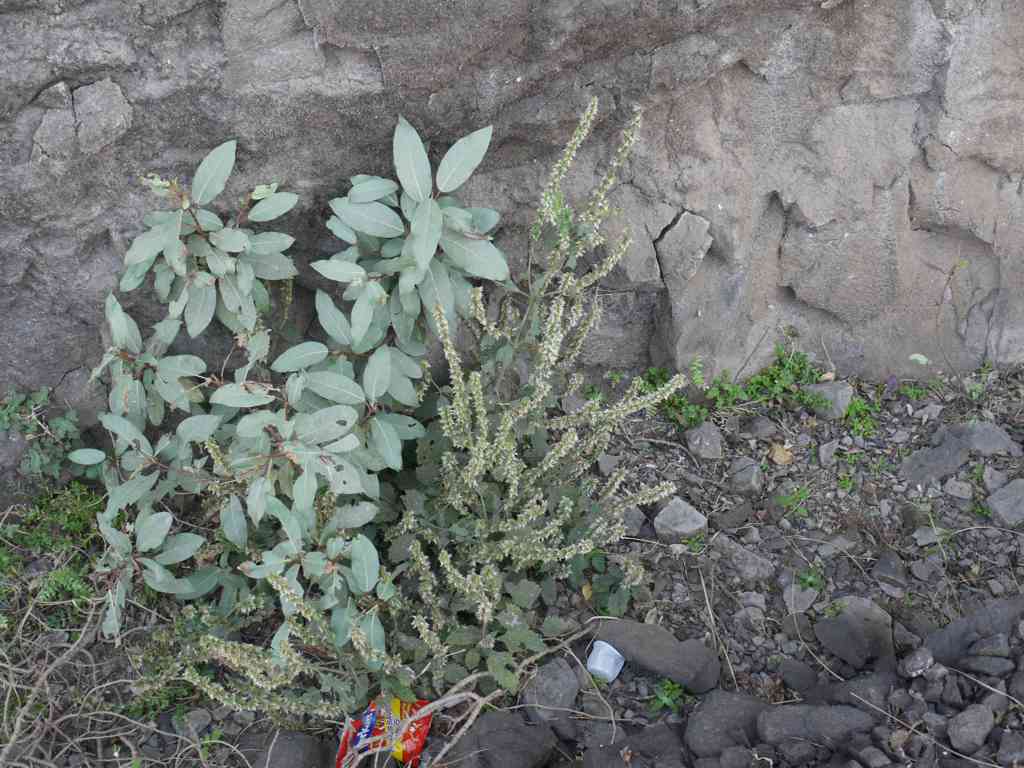.
po-go-STEM-on — from the Greek pogon (beard) and stemon (thread, stamen) … Dave’s Botanary
pan-ick-yoo-LAY-tus — referring to the flower clusters (panicles) … Dave’s Botanary
.
commonly known as: panicled shrub-mint • Hindi: दक्षिणी पचौली dakshini pachouli • Kannada: ಪಚ್ಚೆ ತೆನೆ pacche thene • Konkani: दक्षिणी पाचोली dakshini pacholi • Malayalam: ഭൂതചെടയൻ bhoothachedayan, മലമ്പോത malampotha • Marathi: दक्षिणी पाचोळी dakshini pacholi • Tamil: தென் பச்சுளி then pacchuli
Subshrubs. Leaves to 8 x 4 cm, ovate, acuminate at either ends, irregularly dentate, densely hirtus-tomentose; lateral nerves 3-4 pairs; petiole 2 cm long, tomentose. Panicle large, branches 5-10-flowered, 1-sided; bracteoles 5 x 3 mm, oblique, falcate, imbricating regularly. Flowers densely packed; calyx 4 mm long, 5-ribbed; lobes acuminate, hirtus; corolla purplish, 6 mm long; pubescent outside; filaments bearded.
Flowering and fruiting: October-February
Moist deciduous and semi-evergreen forests, also in wastelands
Peninsular India and Myanmar
(From India Biodiversity Portal
Attributions- Dr. N Sasidharan (Dr. B P Pal Fellow), Kerala Forest Research Institute, Peechi)
.
Herb ID? SN June 31 : 2 posts by 1 author. Attachments (2).
Lamiaceae/ Acanthaceae ? Herb from Bahamandala area of Coorg, Karnataka
Pogostemon paniculatus (Willd.) Benth
Date: 27 DEC 2014 … Altitude: about 80 m asl
ID please
Small herb about 30 – 50 cm high, tiny flower about 2 – 3 mm across.
Pogostemon ¿ species ? … (family: Lamiaceae)
Pogostemon species in eFloraofindia (with details/ keys from published papers/ regional floras/ FRLHT/ FOI/ Biotik/ efloras/ books etc., where ever available)
The one sided turned verticillasters confirm it is Pogostemon paniculatus.
Pogostemon paniculatus (Willd.) Benth.
at Agumbe on December 26, 2014
Chimmony Wildlife Sanctuary, Kerala
November 2014
Pogostemon purpurascens, perhaps.
Thank you sir.
I think Pogostemon paniculatus as per images herein.
.
231 ID wild plant: 12 images.
Please ID wild plant,
Location: near Reserve Forest, Chathamattom, Ernakulam District, (Kochi) Kerala PIN:686671
Altitude: 1400fsl
Flower date: 22.12.2021, 05.05pm
Habitat: wild moisture
Plant habit: erect, branches, slender weak angular stem 03mm base diameter, hairy, aromatic, annual
Height: upto 02 feet
Leaves: opposite, ovate, serrated margins, apex, velvety, aromatic, size:11×6cm or less
Flower: racemose, bracts, size:04×02mm, white, non fragrant
Fruit:
Seed:
Camera: mobile Samsung Galaxy A21s
Pogostemon parviflorus Benth. !
Yes, it is Pogostemon parviflorus dear …, thank you very much for ID my plant,
It is more close to Pogostemon paniculatus,
May be. I am not sure !
Yes, appears close to images at Pogostemon paniculatus
258 ID wild plant Pogostemon: 14 images.
Please ID wild plant,
Location: near Vannappuram Thodupuzha Idukki Dist. Kerala PIN:685607
Altitude: 1500fsl
Flower date: 14.01.2022, 01.15pm
Habitat: wild, moisture, streamside, rocky
Plant habit: small shrub, erect, branches, weak fleshy purple stem 01 inch base (hard) circumference, roots on base stem nodes, annual/perennial
Height: 04 feet
Leaves: opposite, heart shaped, apex, serrated margins, greenish purple, size:06×3cm or less
Flower: racemose, bracts, size:05×2.5mm, violet with white, non fragrant
Fruit:
Seed:
Camera: mobile Samsung Galaxy A21s
I guess Pogostemon paniculatus (Willd.) Benth.
Very close dear …, but different, my ID 231 is Pogostemon paniculatus,
To me also appears close to images at Pogostemon paniculatus
Yes, the flower is same of my ID 231 but this flower is larger at first sight, then colour, glabrous or hairless glossy thick purple stem, hairless or non velvety leaves, height and habit of the plant, life is perennial etc. are different.
If needed more images, I will provide in my next visit. Only one this kind, very rare. And I am agree with whatever your decision,
.
 
I d please – Thrissur OCT 2022: 2 high res. images.
Please identify this.
I think detailed images are required for proper id.
I think this is some other plant. Will post it in a separate mail.
Or is it from the same plant?
yes sir, both images are of same plant
OK
Scrophularia ??
I think looks different from images at Scrophularia
Maybe .. That was my guess based on the 2nd image !
Pogostemon paniculatus
Yes, appears close as per images at
https://efloraofindia.com/2014/07/03/pogostemon-paniculatus/
I also supported …
.
Malayalam names of Pogostemon paniculatus (Willd.) Benth.:
Please validate the Malayalam names that I found during 2nd compilation of names of Pogostemon paniculatus (Willd.) Benth.
Not മനന്പോത, it is മലമ്പോത malampotha (malanpotha is my mistake).
The other one is correct.
Malam means human stool in Malayalam,
Mala മല means hill or alpine. Only Malayalees can understand this pre word related to wild or not 😀
.
Tamil name for Pogostemon paniculatus (Willd.) Benth.:
Please help me with coining a name for Pogostemon paniculatus (Willd.) Benth.
Tamil name for Pogostemon vestitus Benth. is பச்சுளி patchouli
I propose adding a prefix தெற்கு terku describing the species’ major distribution in southern India
Thus the coined name – தெற்கு பச்சுளி terku pacculi for Pogostemon paniculatus (Willd.) Benth.
I have proposed the Tamil name based on lines of names coined for other 3 languages …
• Hindi: दक्षिणी पचौली dakshini pachouli
• Konkani: दक्षिणी पाचोली dakshini pacholi
• Marathi: दक्षिणी पाचोळी dakshini pacholi
The Tamil name “தெற்கு பச்சுளி” (terku pacchuli) sounds okay. “தெற்கு” (terku) usually refers to the direction South. Whereas, the adjective ‘Southern’ can translate to “தென்” (then), “தென்னக” (thennaga), “தெற்கத்திய” (therkathiya) or “தென்னிந்திய” (thennindiya), or sometimes தெற்கு (terku).
So, in this context, “தெற்கத்தி பச்சுளி” (therkathi pacchuli) or “தென் பச்சுளி” (then pacchuli) would be more fitting, but if you prefer “தெற்கு பச்சுளி” (terku pacchuli) that would be fine too.
The spelling patchouli can be written in Tamil as பச்சௌலி.
Thank you for elaborating the subtle differences among “தெற்கு” meaning “south” and the other words in Tamil that mean “southern” … which is what is required.
Among the two options: “தெற்கத்தி பச்சுளி” (therkathi pacchuli) or “தென் பச்சுளி” (then pacchuli) … I will prefer to go with the shorter and easier spoken – தென் பச்சுளி then pacchuli.
Among பச்சுளி pacchuli and பச்சௌலி patchouli, I will go with the former option – because I found பச்சுளி listed in Tamil dictionary as well appears in Googled results.
.
Names of Plants in India :: Pogostemon paniculatus (Willd.) Benth.: 1 image.
Pogostemon paniculatus (Willd.) Benth.
po-go-STEM-on — Greek: pogon (beard); stemon (thread, stamen) … Dave’s Botanary
pan-ick-yoo-LAY-tus — referring to the flower clusters (panicles) … Dave’s Botanarycommonly known as: panicled shrub-mint • Hindi: दक्षिणी पचौली dakshini pachouli • Kannada: ಪಚ್ಚೆ ತೆನೆ pacche thene • Konkani: दक्षिणी पाचोली dakshini pacholi • Malayalam: ഭൂതചെടയൻ bhoothachedayan, മലമ്പോത malampotha • Marathi: दक्षिणी पाचोळी dakshini pacholi • Tamil: தெற்கு பச்சுளி terku pacculi
botanical names: Pogostemon paniculatus (Willd.) Benth. … homotypic synonyms: Elsholtzia paniculata Willd. … heterotypic synonyms: Hyssopus cristatus Lam. … POWO, retrieved 09 April 2024
Bibliography / etymology
Links listed as references in the notes below, may not remain valid permanently. Portals / websites have a tendency to re-organize / revise their content, leading to change in URLs of pages in their site. Some sites may even close down at their own will.
~~~~~ ENGLISH ~~~~~
written and spoken widely, in most parts of India
panicled shrub-mint
~~~~~ HINDI ~~~~~
written in: Devanagari (हिन्दी) … spoken in: Uttar Pradesh, Bihar, Madhya Pradesh, Rajasthan
दक्षिणी पचौली dakshini pachouli
- name coined, for want of name; दक्षिणी dakshini = southern; पचौली pachouli = the vernacular name patchouli given to the herb Pogostemon cablin (Blanco) Benth. … well known for its fragrant essential oil
~~~~~ KANNADA ~~~~~
written in: Kannada (ಕನ್ನಡ) … spoken in: Karnataka
ಪಚ್ಚೆ ತೆನೆ pacche thene
~~~~~ KONKANI ~~~~~
written in: Devanagari (कोंकणी), Kannada (ಕೊಂಕಣಿ), Malayalam (കൊങ്കണി), Perso-Arabic (کونکنی), Romi ( Konknni) … spoken in: Goa, Karnataka, Maharashtra, Kerala, Gujarat दक्षिणी पाचोली dakshini pacholi
- name coined, for want of name; दक्षिणी dakshini = southern; पाचोली pacholi = the vernacular name patchouli given to the herb Pogostemon cablin (Blanco) Benth. … well known for its fragrant essential oil
~~~~~ MALAYALAM ~~~~~
written in: Malayalam (മലയാളം) … spoken in: Kerala, Lakshadweep
ഭൂതചെടയൻ bhoothachedayan, മലമ്പോത malampotha
- Many thanks to Sam Kuzhalanattu for help with these names … efloraofindia
~~~~~ MARATHI ~~~~~
written in: Devanagari (मराठी) … spoken in: Maharashtra, Karnataka
दक्षिणी पाचोळी dakshini pacholi
- name coined, for want of name; दक्षिणी dakshini = southern; पाचोळी pacholi = the vernacular name patchouli given to the herb Pogostemon cablin (Blanco) Benth. … well known for its fragrant essential oil
~~~~~ TAMIL ~~~~~
written in: Tamil (தமிழ்) … spoken in: Tamil Nadu, Puducherry, Andaman & Nicobar Islands
தெற்கு பச்சுளி terku pacculi
- name coined, for want of name; தெற்கு terku = southern; பச்சுளி pacculi = the vernacular name patchouli given to the herb Pogostemon vestitus Benth.
~~~~~ DISTRIBUTION in INDIA ~~~~~
*Andaman & Nicobar Islands, Goa, Karnataka, Kerala, Madhya Pradesh, Maharashtra, *Meghalaya, *Mizoram, Tamil Nadu, *Tripura
- Tagore, Johny & Soosairaj, Sebastian & Rathinam, Sathiyaseelan & Raja, P.. (2015). Two Lamiaceae Members Additions to Flora of Andaman and Nicobar Islands. Journal of the Andaman Science Association. 20. 145-147.
- Datar, Mandar & Lakshminarasimhan, P.. (2013). Check List of Wild Angiosperms of Bhagwan Mahavir (Molem) National Park, Goa, India. Check List. 9. 186-207. 10.15560/9.2.186.
- Das, S., Bora, D., Debbarma, S., Banik, B., Shil, S., & Datta, B. K. (2023). Pogostemon paniculatus (Willd.) Benth. (Lamiaceae) and Cyclocodon lancifolius (Roxb.) Kurz (Campanulaceae): Two new additions to the flora of Tripura, India. Nelumbo, 65(1), 168–170.
- Hassler, Michael (1994 – 2023): World Plants. Synonymic Checklist and Distribution of the World Flora. Version 19.2; last update April 1st, 2024. Last accessed 09/04/2024.
* no given name / no name found, in the regional language(s) of the state
~~~~~ Last updated: 11-04-2024 ~~~~~
Tamil coined name, made more appropriate …
commonly known as: panicled shrub-mint • Hindi: दक्षिणी पचौली dakshini pachouli • Kannada: ಪಚ್ಚೆ ತೆನೆ pacche thene • Konkani: दक्षिणी पाचोली dakshini pacholi • Malayalam: ഭൂതചെടയൻ bhoothachedayan, മലമ്പോത malampotha • Marathi: दक्षिणी पाचोळी dakshini pacholi • Tamil: தென் பச்சுளி then pacchuli
.
Mizo name of Pogostemon paniculatus (Willd.) Benth.:
Pogostemon paniculatus (Willd.) Benth. is known to be distributed in Mizoram.
Please help me with the Mizo name(s) of Pogostemon paniculatus (Willd.) Benth. if any available.
And if not available, please check whether an apt name can be coined.
Mizo name for this plant is not available sir.
.
References:
The Plant List Ver.1.1 WCSP Dinesh Valke’s Flickr Post Flowers of India India Biodiversity Portal
|







